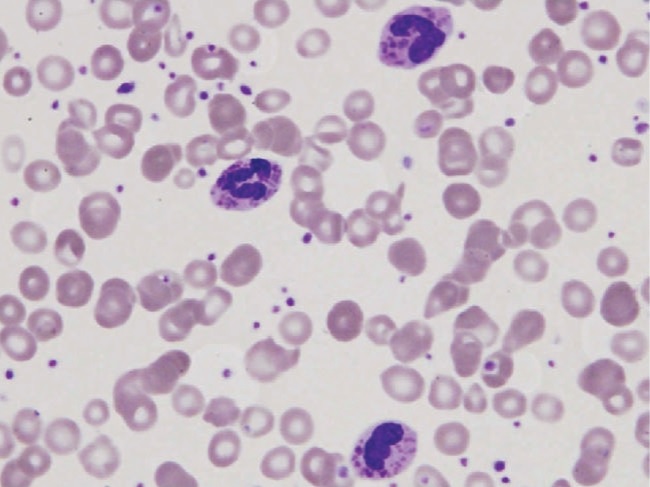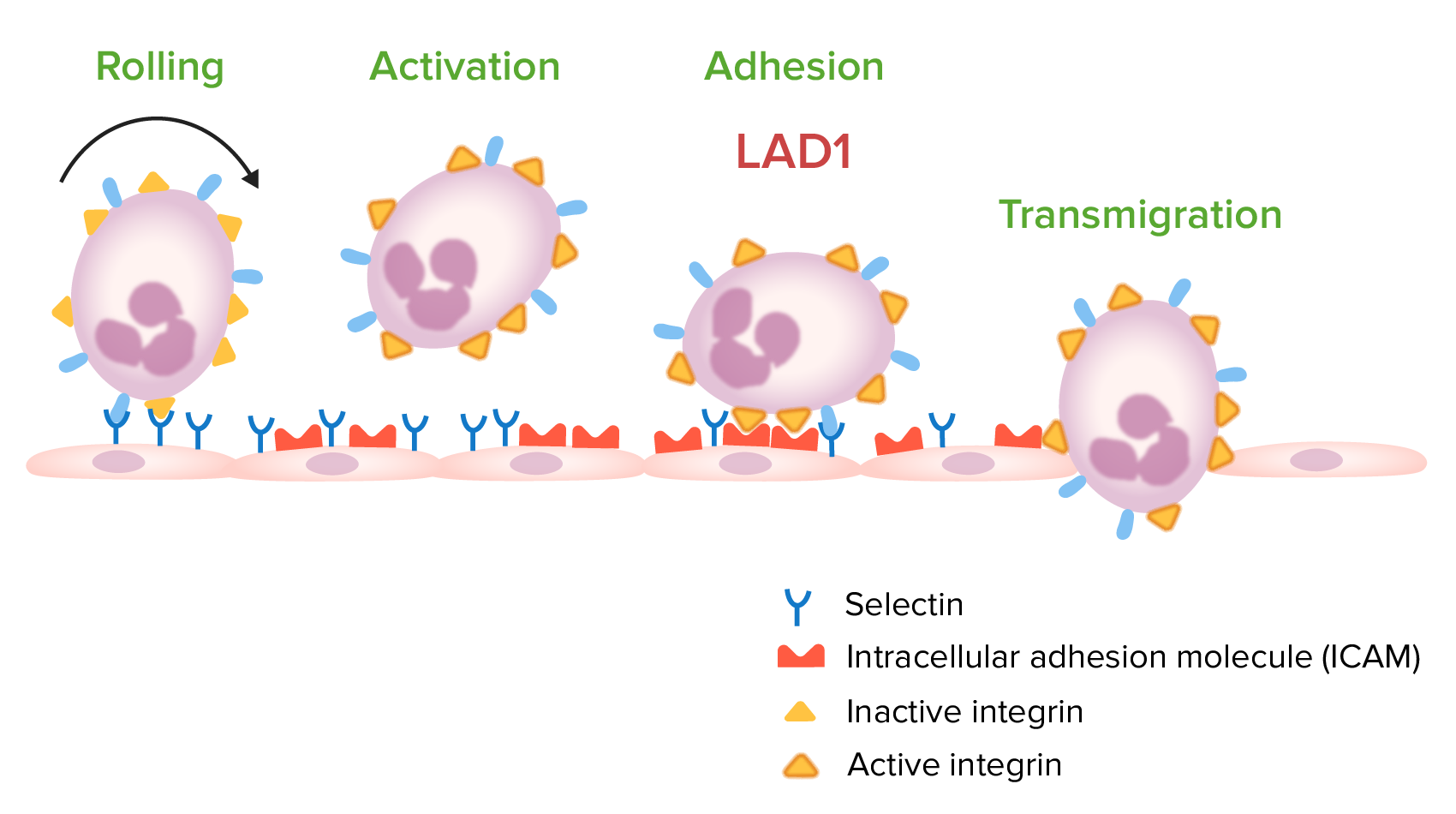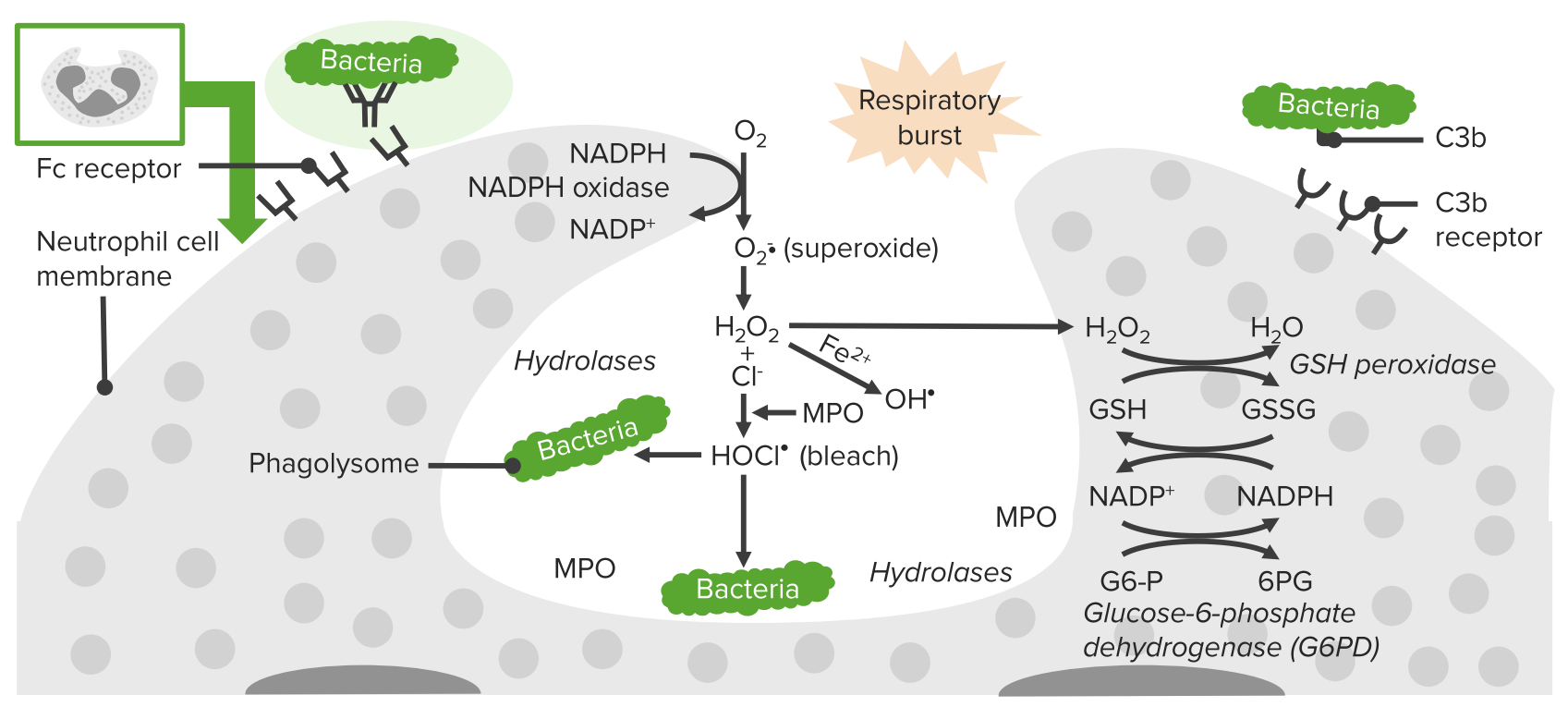Playlist
Show Playlist
Hide Playlist
Phagocytic Cell Disorders – Primary Immunodeficiency
-
Slides Immunodeficiency.pdf
-
Reference List Immune System.pdf
-
Download Lecture Overview
00:01
There are a number of gene defects that can affect
phagocytic cells, and these are listed here.
00:08
Defective genes for components of the NADPH oxidase
can result in chronic granulomatous disease.
00:18
And here we see a number of typical infections,
with an increased instance and severity
of disease with Staph aureus, Aspergillus
fumigatus, Candida albicans and so on.
00:31
A defect in the CD18 β-subunit; CD18 is an integrin adhesion
molecule, leads to leukocyte adhesion deficiency type I.
We see an increased instance
of pyogenic bacteria.
In contrast, a defective gene for the
GDP-fucose transporter leads to leukocyte
adhesion deficiency or LAD II; again, with
an increased incidence of pyogenic bacteria.
Kindlin 3 deficiency leads to
leukocyte adhesion deficiency type
III, again with an increased incidence of pyogenic bacteria.
01:11
And then a defect in the LYST gene leads to
the disorder called Chediak-Higashi syndrome.
01:17
And a range of Staphylococci and Streptococci, and other
species are seen with an increased incidence in this condition.
01:27
Let’s have a look in a little bit more
detail at chronic granulomatous disease.
01:32
In the vast majority of patients,
this is due to a defect in subunits of
the nicotinamide adenine dinucleotide
phosphate oxidase, the NADPH oxidase.
01:42
It affects monocytes,
macrophages and neutrophils.
01:48
And they fail to produce reactive oxygen intermediates
that are required to kill engulfed microorganisms.
01:56
The NADPH oxidase consists of a number of
different subunits as you can see here.
02:04
The function of this oxidase is to produce reactive oxygen
species that are involved in killing engulfed microorganisms.
02:13
A defect in the gene encoding the gp91-phox
component of the NADPH oxidase, is the
X-linked form of this disease because
that gene is present on the X chromosome.
02:29
The genes for the other components of the NADPH oxidase are
found on the non-sex chromosomes, in other words, the autosomes.
02:37
And the autosomal recessive p22-phox, p47-phox,
p40-phox or p67-phox variants of chronic
granulomatous disease are caused by gene
defects in these particular autosomal genes.
02:58
In a minority of patients, rather than having
gene defects in components of the NADPH oxidase,
there can be genetic mutations in the myeloperoxidase
or glucose-6-phosphate dehydrogenase genes.
03:14
This leads to a similar but less
severe phenotype in these patients.
03:21
Turning now to leukocyte adhesion deficiency;
as we’ve already heard, there are three types.
03:29
LAD type I is due to a lack of the
CD18 β subunit of the β2 integrins.
03:36
LAD type II is due to defective GDP-fucose transporter, and
therefore an inability to fucosylate sialyl Lewis structures.
03:50
Whereas LAD type III is due to a mutation in
the integrin activation molecule, kindlin 3.
03:58
So any one of these three gene defects,
in different ways can lead to defective
adhesion of leukocytes and compromise
the ability to fight infection.
04:12
In Chediak-Higashi syndrome, there’s a defect
in the LYST (lysosomal trafficking) gene.
04:19
There’s an accumulation of giant
intracytoplasmic granules.
04:23
This is due to defective migration of
the late endosomal/lysosomal compartment
within the cell, which interferes with
the correct function of these cells.
04:34
There is dysfunction of neutrophils, of natural
killer cells, and of cytotoxic T-cells.
04:41
And here we can see a neutrophil with
these giant granules accumulating
within the cell, and this compromises the function of the cell.
04:50
Likewise, in the natural killer cell and in
the cytotoxic T-cell, these large granules
accumulate in the cytoplasm and interfere
with the correct activity of the cell.
05:02
Patients suffer from a range of pyogenic
infections, particularly with Staph aureus,
Strep pyogenes, Pneumococci, Aspergillus
species and Pseudomonas aeruginosa.
About the Lecture
The lecture Phagocytic Cell Disorders – Primary Immunodeficiency by Peter Delves, PhD is from the course Immunodeficiency and Immune Deficiency Diseases. It contains the following chapters:
- Defects of Phagocytic Cells
- Chronic Granulomatous Disease
- Leukocyte Adhesion Deficiency
- Chediak-Higashi Syndrome
Included Quiz Questions
X-linked chronic granulomatous disease (XL-CGD) arises due to mutations in which of the following genes?
- gp91phox
- p22phox
- q26-qter
- Xq28
- 19q13.1
Which of the following conditions is caused by mutations in the lysosomal trafficking regulator (LYST) gene?
- Chediak-Higashi syndrome
- Leukocyte adhesion deficiency II
- Chronic granulomatous disease
- Glucose-6-phosphate dehydrogenase deficiency
- Leukocyte adhesion deficiency III
Which of the following defects causes leukocyte adhesion deficiency type 3?
- Kindlin 3
- Cluster of differentiation 18 β-subunit
- Guanosine 5′-diphospho-β-L-fucose transporter
- Fucosylation of sialyl Lewis X structure
- Nicotinamide adenine dinucleotide phosphate oxidase
Chediak-Higashi syndrome most strongly affects which types of immune cells?
- Neutrophils and macrophages
- B lymphocytes and plasma cells
- Helper T cells
- Regulatory T cells
- Dendritic cells
Customer reviews
5,0 of 5 stars
| 5 Stars |
|
5 |
| 4 Stars |
|
0 |
| 3 Stars |
|
0 |
| 2 Stars |
|
0 |
| 1 Star |
|
0 |






